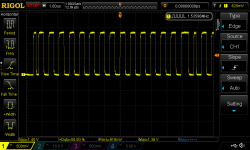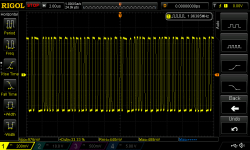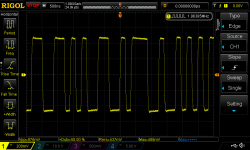The first thing: when you take captures with the oscilloscope, put the channel reference in the grid so that the data can be read more easily on the screen.
The image shows dampened oscillations and fairly large negative spikes. If there are no setup errors (poorly chosen ground point, long connection for the GND of the probe, etc.), then the signal is not very good.
Otherwise, I don't know what data is transmitted there. Did you overlap multiple triggers?
The image shows dampened oscillations and fairly large negative spikes. If there are no setup errors (poorly chosen ground point, long connection for the GND of the probe, etc.), then the signal is not very good.
Otherwise, I don't know what data is transmitted there. Did you overlap multiple triggers?
Yeah for some reason the scope can't trigger this signal properly. I got another SPDIF source and the signal is better, DIR9001 outputs data and valid clock signals, but now the DAC doesn't output anything.
Clock is 512fs, bit stream is 24bit MSB left justified.
Attached is the SPDIF signal.
Clock is 512fs, bit stream is 24bit MSB left justified.
Attached is the SPDIF signal.
Attachments
When you say the scope won't trigger on the first signal properly, its not clear how much experience you have with capturing such waveforms on a digital scope? The reason I ask is because usually there is a way to get the scope to trigger the way you need it to.
Anyway, would you like some help taking a look at the SPDIF waveforms, the I2S data, etc., in order to help see why no sound?
If so, the SPDIF signal you posted on #122 doesn't look like it has a big music signal encoded on it. Its mostly just clock pulses. There should be more long pulses at least some of the time if music is playing at normal volume levels. Then then the I2S DATA signal should be showing varying length pulses which correspond to normal volume level music.
Or, we could go back and work on getting the scope to trigger with the first SPDIF signal you posted in #119.
Also if using AK4118 dac, how is it configured, for LJ? Moreover, with all the threads I have been reading I don't recall if you have an up to date schematic? Not sure where you are measuring with scope, not sure if you are using a spring ground or where the scope ground is connected physically. IOW, there is some stuff you know which those of us reading along don't know, and some of that stuff could be important to solving the problems.
Anyway, would you like some help taking a look at the SPDIF waveforms, the I2S data, etc., in order to help see why no sound?
If so, the SPDIF signal you posted on #122 doesn't look like it has a big music signal encoded on it. Its mostly just clock pulses. There should be more long pulses at least some of the time if music is playing at normal volume levels. Then then the I2S DATA signal should be showing varying length pulses which correspond to normal volume level music.
Or, we could go back and work on getting the scope to trigger with the first SPDIF signal you posted in #119.
Also if using AK4118 dac, how is it configured, for LJ? Moreover, with all the threads I have been reading I don't recall if you have an up to date schematic? Not sure where you are measuring with scope, not sure if you are using a spring ground or where the scope ground is connected physically. IOW, there is some stuff you know which those of us reading along don't know, and some of that stuff could be important to solving the problems.
Last edited:
I'm not sure what exactly is going on with the scope, I've used it for many types of signals before and never had issues. Tried different probes, channels, auto mode etc. What I don't know is how a SPDIF signal should look like, and I hadn't had much time to look up the protocol in detail. The last waveform was captured in single shot. I also probed with another scope, I don't get the trigger issues there (but that's an isolated scope).
This second SPDIF source is known to work (tested) and the signal was a ~1kHz sine tone. The signal was probed across the 75R resistor.
The I2S signals were probed at R28/29/12/13 and they're correct, I checked all the frequencies with the configuration and I can see the duty cycle of the data line signal changing.
The schematic posted at #119 is up to date.
This second SPDIF source is known to work (tested) and the signal was a ~1kHz sine tone. The signal was probed across the 75R resistor.
The I2S signals were probed at R28/29/12/13 and they're correct, I checked all the frequencies with the configuration and I can see the duty cycle of the data line signal changing.
The schematic posted at #119 is up to date.
A SPDIF signal looks like a irregularly spaced, possibly non-repeating pulse train. It means we have to capture it in one sweep only, because its constantly changing. Then if we capture a few single-sweeps, we can compare them to see how the signal is changing over time.
So the first thing is to put your scope in single sweep mode. Usually the sweep trigger modes are, Auto, Normal, and Single. Do you know the differences?
The Auto trigger mode in the case is different from the AUTO button that tries automatically set up all the scope parameters for you.
Also, when you see a lot of ringing like for your first SPDIF signal, the first thing to do is capture a close-up of one cycle. Maybe even a close up of each edge. See what's going on. Sometimes the peaks will be much higher when you zoom in. That can cause triggering problems when you zoom out if you don't know the real signal levels.
...
Anyway, if you put the scope in single mode, you may be able to trigger it manually using the Force button. You may also be able to trigger on a peak level by setting the mode to Normal, and setting the trigger level very high so the scope is never triggered by the waveform. Then slowly reduce the trigger level knob until you get a trigger. If in single sweep mode, the scope should then go into Stop mode so the captured waveform will be saved until you are done looking at it and or saving it. Then you can put the scope back in Run mode to capture another sweep.
Also, as you are trigging the scope in single sweeps you can try changing the sweep rate/frequency knob to capture one pulse or many. You can capture as many as you usefully tell apart on the screen. Some scopes can capture more than you can see on the screen at one time. Once the trigger and sweep are complete and the scope and puts itself in Stop mode, on those scopes with large memories you can then scroll through the long captured waveform/pulse-train, zoom-in, etc.
Some scopes may also have the ability to decode certain types of captured pulse trains, such as I2C, SPI, etc.
So the first thing is to put your scope in single sweep mode. Usually the sweep trigger modes are, Auto, Normal, and Single. Do you know the differences?
The Auto trigger mode in the case is different from the AUTO button that tries automatically set up all the scope parameters for you.
Also, when you see a lot of ringing like for your first SPDIF signal, the first thing to do is capture a close-up of one cycle. Maybe even a close up of each edge. See what's going on. Sometimes the peaks will be much higher when you zoom in. That can cause triggering problems when you zoom out if you don't know the real signal levels.
...
Anyway, if you put the scope in single mode, you may be able to trigger it manually using the Force button. You may also be able to trigger on a peak level by setting the mode to Normal, and setting the trigger level very high so the scope is never triggered by the waveform. Then slowly reduce the trigger level knob until you get a trigger. If in single sweep mode, the scope should then go into Stop mode so the captured waveform will be saved until you are done looking at it and or saving it. Then you can put the scope back in Run mode to capture another sweep.
Also, as you are trigging the scope in single sweeps you can try changing the sweep rate/frequency knob to capture one pulse or many. You can capture as many as you usefully tell apart on the screen. Some scopes can capture more than you can see on the screen at one time. Once the trigger and sweep are complete and the scope and puts itself in Stop mode, on those scopes with large memories you can then scroll through the long captured waveform/pulse-train, zoom-in, etc.
Some scopes may also have the ability to decode certain types of captured pulse trains, such as I2C, SPI, etc.
Last edited:
Okay, thank you. At face value they look reasonably plausible. Do you see anything similar coming out on the DATA pin of the SPDIF receiver?
Also, was this measurement taken at the SPDIF input jack, or at the input pin of the SPDIF receiver chip, or somewhere else?
Also, was this measurement taken at the SPDIF input jack, or at the input pin of the SPDIF receiver chip, or somewhere else?
Last edited:
This seems to be a good SP/DIF signal BUT its amplitude is much too high for a SPDIF signal and much too low for a 3.3V digital signal.
U2 should be 74HCU04 (unbuffered) which is used as linear amplifier in this circuit. Buffered version (74HC04) does not work.The schematic posted at #119 is up to date.
For using 74HCU04 as linear amp see e.g. https://www.qsl.net/l/lu7did/docs/QRPp/TTL_74HC04 As Linear Amplifier_SPRATCD.pdf
That might be the issue then. Sadly I don't have the 74HCU04.U2 should be 74HCU04 (unbuffered) which is used as linear amplifier in this circuit. Buffered version (74HC04) does not work.
I've read that DIR9001 is better (lower jitter, better specs).Just use CS8416. It work better and you have multiple other facilities.
Yes.Do you see anything similar coming out on the DATA pin of the SPDIF receiver?
At the SPDIF input jack.Also, was this measurement taken at the SPDIF input jack, or at the input pin of the SPDIF receiver chip, or somewhere else?
First it has to work, then it has to work well, and then to hope to get better performance than the CS8416 you have to have an exceptionally good project in terms of design and layout, and an amplifier that it amplifies your SP/DIF signal without altering the performance of the DIR9001, it is very very difficult to do, especially cheap. You can look for integrated dedicated for this, but they are not cheap and not easy to find.I've read that DIR9001 is better (lower jitter, better specs).
I have several dozen new, unused DIR9001s. I bought them (over 10 years ago) when I started designing and then made my DAC, but now they sit in a drawer without use and will probably go to recycling. They didn't pass my tests.
On paper, many things look good, but in practice...
There is a saying: Theory is theory, but practice kills us.
Yes, I missed the fine print in the datasheet where it says that DIR9001 needs an amplified SPDIF signal. But it's easy to source and relatively cheap, so it's worth choosing it.
BTW, don't throw the chips away, send them to a fellow DIYer 😊
BTW, don't throw the chips away, send them to a fellow DIYer 😊
- Home
- Source & Line
- Digital Line Level
- AK4493 + AK4118 DAC


